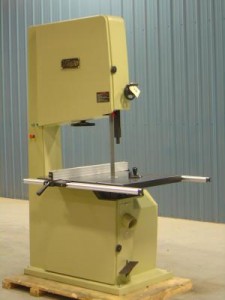 Saw machine operators use saws to cut, shape, and profile wood stock. The saws they use include: ripsaws, bandsaws, cut-off saws, handsaws, circle saws, and planers. Some saw machine operators also use welding equipment to cut and shape metal pieces used in woodworking. At large woodworking companies, saw operators may operate a specific type of saw. At small companies, they typically operate various saws. In either case, saw machine operators are responsible for the following tasks:
Saw machine operators use saws to cut, shape, and profile wood stock. The saws they use include: ripsaws, bandsaws, cut-off saws, handsaws, circle saws, and planers. Some saw machine operators also use welding equipment to cut and shape metal pieces used in woodworking. At large woodworking companies, saw operators may operate a specific type of saw. At small companies, they typically operate various saws. In either case, saw machine operators are responsible for the following tasks:
• Adjusting saw blades with wrenches and rulers, or by accessing pedals, levers, control dials, etc.
• Switching out saw blades based on wood stock and cutting procedure requirements.
• Inspecting work pieces with calipers, rulers, squares, and other measuring instruments to ensure cutting accuracy.
• Examining logs and raw lumber to estimate their quality and assess cutting plans.
• Operating panel boards to convey wood stock through automated production lines.
• Operating welding machines when projects require metal work.
• Monitoring saw machines during the cutting process and adjusting their controls as necessary.
• Performing servicing and light repairs on saw machines and other cutting equipment.
• Performing hand sawing to remove unnecessary wood that results from wide cuts.
Required knowledge
Saw machine operators require the following forms of knowledge to carry out their tasks:
• Mechanical knowledge of used woodworking machines, particularly how to operate and service them.
• Production/processing knowledge of raw materials, quality control, and cost control.
• Construction knowledge of the construction process for certain wood products.
• Mathematical knowledge of algebra, geometry, calculus, statistics and arithmetic.
• Educational knowledge of saw machine practices to train new workers.
Required abilities and skills
Saw machine operators require the following abilities and skills to carry out their tasks:
• Manual dexterity for grasping tools and adjusting saw machine settings.
• Critical thinking for resolving unexpected sawing or conveyor line issues.
• Verbal skills for communicating information to team members and trainees.
• Near vision for observing the details of finished work pieces.
• Physical endurance for moderate to heavy lifting and standing for extended periods of time.
Job statistics
As of 2008, 53,000 saw machine operators/setters are employed in the U.S., with little to no employment growth projected between 2008 and 2018. As of 2009, the annual median salary for saw machine operators is $26,010 ($12.51/hour). According to a national work survey, 48% of saw machine operators/setters have less than a high school diploma or the equivalent; 41% have a high school diploma or the equivalent, and 11% have attended college. Most machine operators/setters are employed in the manufacturing industry.
To learn more about becoming a saw machine operator, contacting a trade school that offers courses in woodworking or shadowing saw machine operators at a woodworking company are excellent options. Saw machine training may also be available through some apprenticeship programs.




